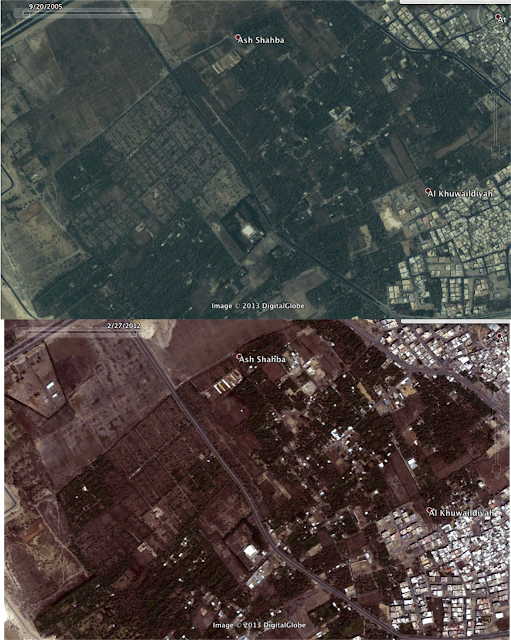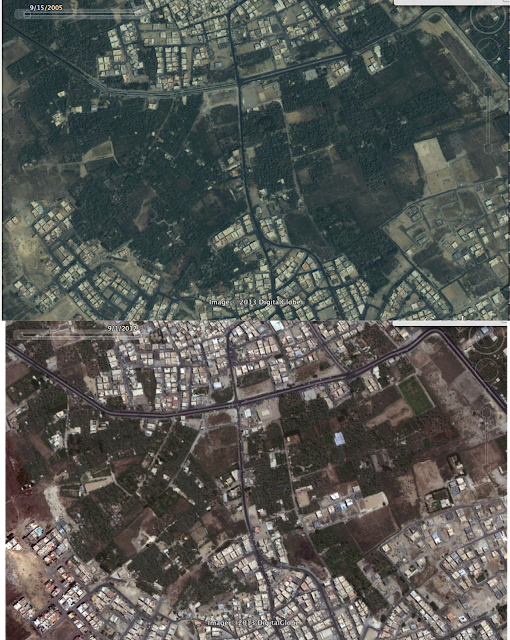"The region is the most intensely utilized irrigated land along the Saudi Arabian coast of the Persian Gulf. The relative ease with which abundant water can be obtained from the aquifers coupled with the availability of a sizable area of level land provides a partial explanation for the notable role this region has come to play as the leading coastal oasis of the Eastern Province."
 |
| The Qatif Region as highlighted in Professor Charles Ebert's 1965 article published in the Journal of Geographical Review by the American Geographical Society (source). He specifically indicated that Qatif's influence extends from Jubail in the north all the way to Abqaiq in the south. |
"A clear need exists for a long-range water-conservation policy."In addition to all the provided detailed recommendations he suggested in the article, professor Ebert emphasized that his suggestions should be implemented in a way to "ensure the smallest amount of communal upset and dislocation in the way of life of the people of Qatif, a factor that should not be underrated".
 |
| A colored picture taken in 1952 showing the Hammam of Tarout in Tarout Island. The picture summarizes the "the way of life of the people of Qatif" that professor Ebert was concerned with preserving. (source) |
"Although time seems to stand still in the quiet palm gardens of Al Qatif, the proximity of rapidly growing administrative and commercial centers cannot be overlooked. One of these is the port town of Al Khobar, near Dhahran, which has grown into an important commercial center that reflects the increasing demand for shopping and other service facilities for the people associated with the nearby oil industry. Other rapidly growing towns are Dammam, capital of the Eastern Province, Safwa and Al Jubail, and the Aramco centers of Dhahran, Abqaiq, and Ras Tanura. These growing settlements, and their increasing requirements for foodstuffs, will place an ever greater demand on the production capacity of Qatif's agriculture".The growing small settlements and towns that professor Ebert mentioned in his article grew exponentially to become one of the most heavily urbanized areas of Saudi Arabia, as seen below.
 |
| The modern Qatif Oasis is under the menace of urban encroachment, as it is situated at the heart of the Eastern Province conurbation of of Khobar-Dhahran-Dammam-Ras Tanura all the way to Jubail. |
However, Ebert emphasized that it is the responsibility of the authorities in Qatif to legislate and implement policies in favor of his suggestions. The reality of Qatif's "green landscape" seen from the aerial view below reflects the failure of the Eastern Province's authorities and Saudi Arabian government in ensuring the preservation of a vibrant "oasis lifestyle" which has been completely lost as a result of urban encroachment and lack of a water-conservation program.
 |
| The green-landscape of the Qatif Oasis has been effectively reduced to narrow areas that are increasingly depleted due to negligence and urban encroachment. |
Professor Charles Ebert recommended that "part of the oasis land" should be allocated "to deep, effective drainage channels" so that Qatif can "be saved from eventual destruction".
Let's look at what happened to the existing ancient drainage channels, re-built by the Ottomans, between 2005 and 2012.
 |
| Urban Encroachment around the agricutlural lands between Saihat and Anak. |
 |
| Urban Encroachment around the agricutlural lands between Saihat and Anak. |
 |
| Urban Encroachment around the agricutlural lands between Saihat and Anak. |
 |
| Urban Encroachment around the agricutlural lands between Saihat and Anak. |
 |
| The expansion of Al-Qudaih village came at the expense of agricultural lands. |
 |
| The reduction in agricultural lands between the towns of Al-Qudaih and Al-Awamiyah. |
 |
| The rural areas around Al-Awamiyah has been subject to urban encorachment from 2005 to 2012. |
 |
| The rural and agricultural lands around the city of Safwa also suffered urban encroachment between 2005 & 2012. |
 |
| Notice the reduction and desertification of green-lands. |
 |
| Loss of agricultural land in the center. |
 |
| The villages of Al-Mallahah, Umm Al-Hammam and Al-Jish increased their urban area at the expense of agricultural land. |
 |
| While areas from land-reclamation projects have remained absent of any urbanization due to corruption issues, the agricultural lands became the only alternative for building urban dwellings. |
 |
| Changes in agricultural lands around the Al-Khuwaildiyah village from 2005 to 2012. |
 | |
|
 |
| Urbanization in rural areas. |
 |
| Agricultural lands turned into urban dwellings around Al-Riyadh street in the village of Al-Jaroudiya. |
 |
| Little remains of the agricultural lands around the city of Qatif. This image is for the areas south of al-Majidiah commercial & Warehouses area. |
 |
| Even the village of Halat Mahish was affected. |
 |
| Urbanization in Al-Jaroudiya is taking place at the expense of agricultural land. |
 |
| Agricultural lands between Saihat and Anak. |
 |
| Negligence of green areas has resulted in them being converted to barren lands, as clearly marked in the top of the images. |
 |
| Rural areas around Al-Mallaha village. |
 |
| Rural areas around Al-Mallaha village. |
 |
| Additional evidence of urban encorachment. |
 |
| Negligence has reduced most of the green areas to barren lands. |
 |
| The area of Qatif's ancient Fortified City and the surrounding palm-tree forests have been converted to urban areas. |
Evidently, there exists a desperate need for a well-organized public campaign to push the government to legislate laws and policies for the protection of the surviving agricultural lands of the Qatif Oasis. In particular, the government of Saudi Arabia should allocate a reasonable part of the green areas as a national sanctuary and a natural reserve. A protected area of the Qatif oasis would preserve the unique wildlife, flora, fauna and geographical features, and would help ensure the systematic conservation of the oasis, providing an ideal environment for study and research.



الشركات هي مصدر من مصادر الدخل بالنسبة لرجال الأعمال والعاملين فيها شركة تنظيف دبى ويتم دخول وخروج عدد كبير من المتعاملين مع الشركة بصورة يومية شركة مكافحة حشرات بدبيشركة تنظيف عجمان لها أمام العملاء، ولذلك فصاحب الشركة شركة مكافحة الحشرات بالشارقة يحتاج توفير طاقم عمل شركة تنظيف بالشارقةيقوم بالتنظيف المستمر للشركةشركة مكافحة الحشرات ابوظبي وتقدم شركتنا مجموعة من الخدمات التنظيفية المتنوعة في مجال تنظيف الشركات شركة تنظيف ابو ظبي
ReplyDelete